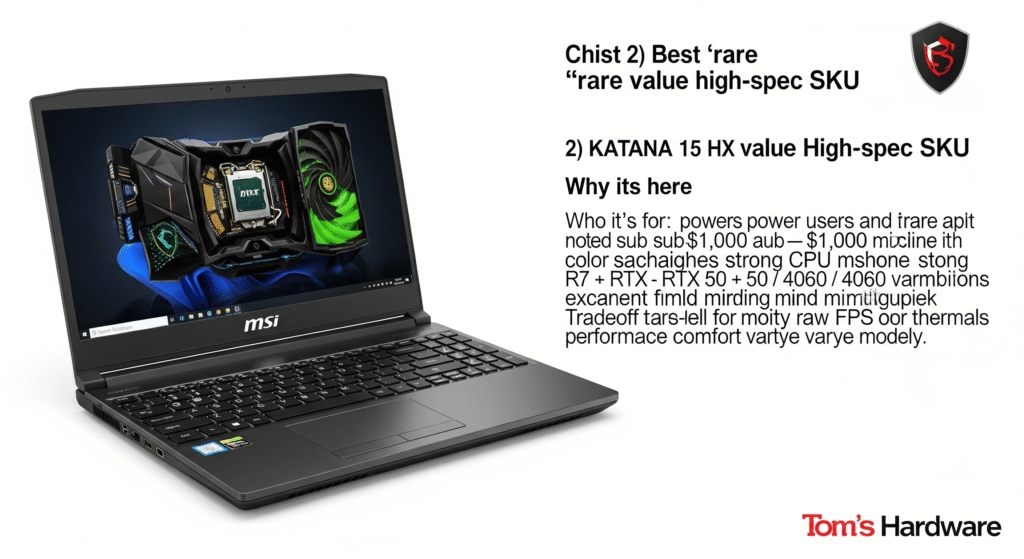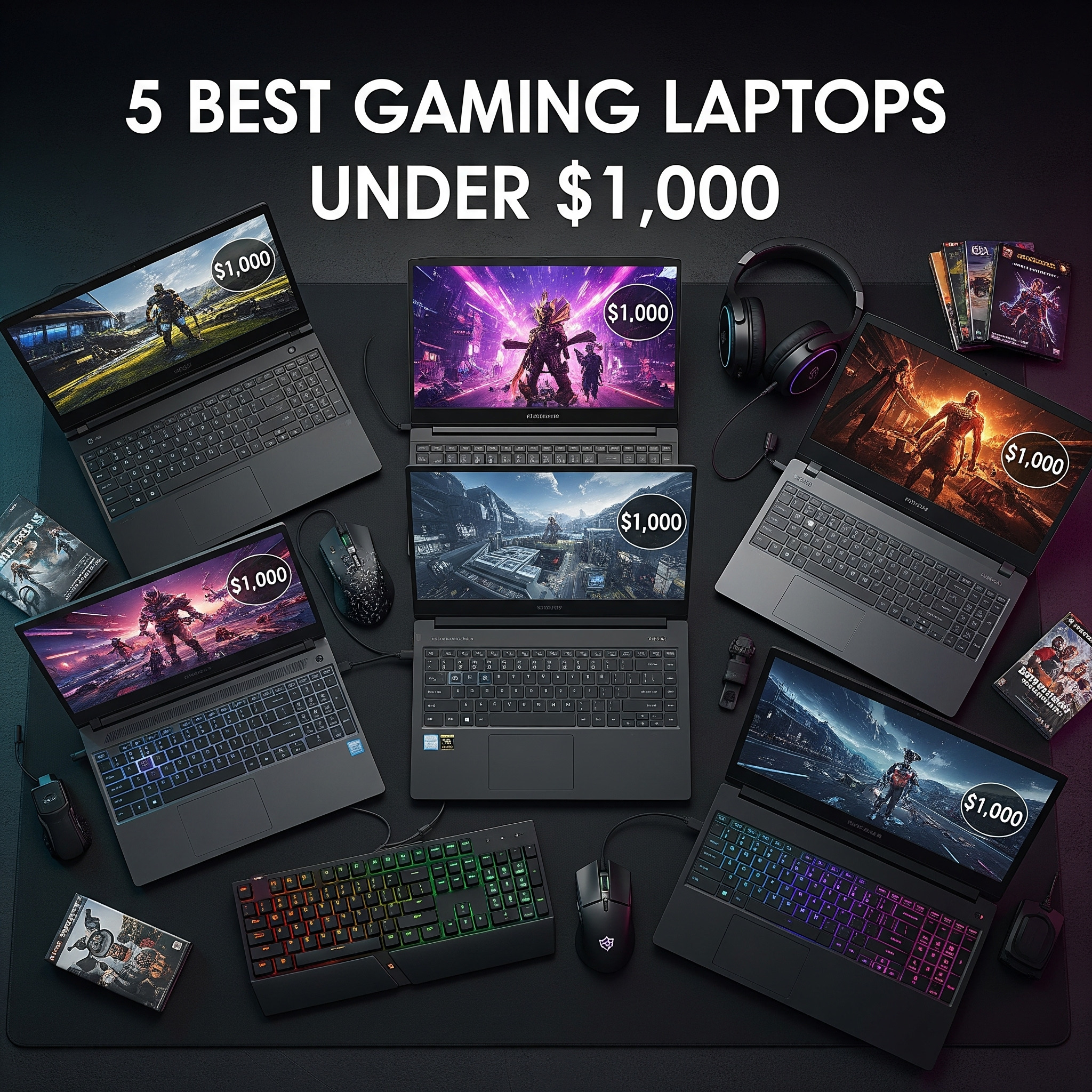Quick takeaway: As of late 2025 you can still find legitimate gaming laptops under $1,000 — usually when manufacturers or retailers run sales — and the best options focus on mid-range GPUs (RTX 4060/4060-class or newer budget RTX chips), a strong CPU (Intel i5/i7 or Ryzen 5/7), 16GB RAM, and at least 512GB SSD. Expect tradeoffs in display brightness/quality, chassis weight, and battery life compared with premium machines.
The short list — 5 picks (what to buy right now)
1-Dell G16 (7630) — best overall value when it’s on sale (often configurable with RTX 4060 + 16GB RAM + 1TB SSD at under $1,000). Great balance of CPU, GPU and display for 1080p gaming.
2- MSI Katana 15 HX — rare solid spec at sub-$1,000: Intel i7 + RTX 5050/4060-class configurations seen in deals; strong 1080p performance if you don’t require a top-tier display.
3- Acer Nitro series (15/16/17) — consistent budget pick. When discounted you can get good GPU/CPU combos and a high-refresh panel for competitive games. Good price/performance for the money.
4- Lenovo LOQ / Legion (select SKUs) — Lenovo’s gaming sub-brands sometimes land aggressive configs (Ryzen + RTX 40-series) under $1,000 during promotions. Great thermals and keyboard for the price.
5- Gigabyte / AORUS or MSI GF series (discounted models) — often show up as the value option — “good GPU, modest display, solid thermals” when on sale. Shop discounts.
Notes: these picks reflect laptops that review sites and deal trackers were listing as solid buys under or around $1,000 through 2025. Availability changes fast; treat this as a snapshot and use the buying checklist below to pick the exact SKU that fits you.
Why these models? (what makes a good $1,000 gaming laptop)
Here’s the simple logic: at ~$1,000 you want hardware that will run modern titles at 1080p with playable frame rates while giving you some future headroom. That means:
GPU — target: Nvidia GeForce RTX 4060 if possible (or equivalent), or the newer budget RTX series seen in 2025 models. These GPUs give consistent 60+ fps in many titles at 1080p with sensible settings.
CPU — at least Intel Core i5/Ryzen 5; prefer i7/Ryzen 7 for longer life. Many sub-$1,000 deals use HX/H-series chips that are powerful for gaming and streaming.
Memory — 16GB is the sweet spot. 8GB is increasingly a bottleneck.
Storage — 512GB NVMe minimum; 1TB is ideal. Some budget SKUs pair 512GB with an open slot to upgrade later.
Display — 1080p + 120–240Hz is common on budget gaming laptops. Higher refresh rate helps competitive games; check brightness (some budget panels are dim or washed out).
Thermals & Build — gigs matter more than looks: good cooling = higher sustained FPS and longer component life. Budget laptops vary a lot here — read real reviews.

Deep dive: each pick (specs, who it’s for, plus the tradeoffs)
1) Dell G16 (7630) — Best overall value when discounted
Why it’s here: when on sale this line hits the sweet spot — RTX 4060, i7/H-series processors, 16GB RAM and a high-refresh display — for < $1,000. Reviewers call it a “master class example” of budget gaming when priced right. Great keyboard and a balanced chassis.
Who it’s for: gamers who want good 1080p/competitive performance and a better display/keyboard than most budget machines.
Tradeoffs: can be heavier; battery life is average; its best configurations usually require catching a sale.
2) MSI Katana 15 HX — Best “rare” value high-spec SKU
Why it’s here: Tom’s Hardware and others noted the Katana HX as a rare sub-$1,000 machine with strong CPU+GPU combos (i7 + RTX 50-series / 4060 variants). If you find the right SKU, performance per dollar is excellent.
Who it’s for: power users on a tight budget who don’t mind middling display quality in exchange for raw FPS.
Tradeoffs: display brightness and color may be weak; thermals and keyboard comfort vary by model.
3) Acer Nitro (15/16/17) — Consistent budget champ
Why it’s here: Acer’s Nitro often shows the best price-to-performance across seller discounts (Nitro 15/16/17 models). They frequently offer RTX 4050/4060 or equivalent GPUs with decent displays and upgradeable internals — ideal for future-proofing on a budget.
Who it’s for: buyers who want a balanced package, easy upgrade paths, and steady value during sales.
Tradeoffs: build is usually plastic and heavier; audio/display aren’t flagship level.
4) Lenovo LOQ / Legion (select SKUs) — Strong thermals & keyboard
Why it’s here: Lenovo’s gaming brand occasionally drops aggressive SKUs under $1,000 (Ryzen + RTX 40-series). Reviewers praise thermal management and typing feel, which matter for long sessions.
Who it’s for: gamers who also do productivity and value a reliable keyboard and cooler running temps.
Tradeoffs: some SKUs use lower-tier displays to hit the price point.
5) Gigabyte / MSI GF series (budget lines) — Best if you’re deal-savvy
Why it’s here: these are the models that regularly appear in deal roundups: solid chassis, acceptable screens, and GPUs that can handle 1080p well if you buy the right SKU or catch a sale. Look to retailers and seasonal sales for sub-$1,000 pricing.
Who it’s for: price-conscious buyers who will upgrade storage/RAM later and prioritize raw framerate over color accuracy.
Tradeoffs: panels can be bland; battery life and build quality vary.
The no-nonsense buying checklist (use this before you hit Buy)
- GPU first — RTX 4060 or better if you can find it under $1,000. If not, an RTX 3050/4050 will still play modern games at lower settings.
- CPU second — prefer recent i5/i7 H-series or Ryzen 5/7 HS/H-series. HX/H give more headroom.
- RAM = 16GB — if a laptop ships with 8GB but has an extra slot, plan to upgrade ASAP.
- Storage = 512GB NVMe minimum — games fill SSDs fast; check for extra M.2 slot.
- Panel — 1080p at 120Hz+ is fine; look at brightness (nits) if you plan to use outdoors — budget panels can be dim.
- Thermals — read real reviews (sustained FPS tests). Throttled chips mean lower real-world performance.
- Ports & Upgradeability — at least one USB-C (with DisplayPort/PD if possible), multiple USB-A, Ethernet is a plus for latency. Check if RAM/SSD are user-upgradeable.
- Keyboard & Trackpad — don’t buy sight unseen if keyboard feel matters. Reviews often call out poor trackpads on budget models.
- Weight & battery — gaming laptops are heavy; if portability is critical, prepare to pay more or accept lower performance.
- Warranty & returns — buy from reputable sellers with a decent return window.
Realistic expectations (what you won’t get for $1,000)
- No ultraportable thin & light with RTX 4070-level sustained performance.
- No OLED 4K panels.
- Battery life will generally be mediocre under gaming loads.
- Premium materials or ultra-bright color-accurate displays.
If you need those things, raise the budget or look at used/renewed higher-tier models. Tom’s Hardware notes budget availability is limited and depends heavily on deals.
How to hunt the best deal (step-by-step)
- Set alerts on price trackers (CamelCamelCamel, Honey, or retailer alerts).
- Check multiple sellers — Best Buy, Amazon, Walmart, Newegg, manufacturer stores often rotate models and discounts. LaptopMag deal pages are a good weekly resource.
- Time your buy — big sale windows (Memorial Day, Back-to-School, Black Friday, Prime Day) often push these models below $1,000.
- Consider last-year models — same chassis, previous-gen GPUs at big discounts can be the best value.
- Check refurbished — manufacturer-refurbished units can come with warranty at a lower price.
- Factor upgrade cost — sometimes a cheaper laptop + 16GB RAM + 1TB SSD gives you a better machine than a preconfigured SKU.
Quick buying scenarios (choose your path)
- Competitive FPS player: prioritize 144–240Hz panel + RTX 4060, good cooling, 16GB RAM.
- Mixed gaming + streaming: favor stronger CPU (i7/H-series) and 16GB+ RAM.
- Budget single-player: RTX 3050/4050 with 16GB RAM and a 1080p 144Hz screen is fine.
- Portable/light use: accept lower GPU to get a slimmer chassis (but gaming performance will drop).
Short FAQ
Q — Are these laptops future-proof?
Short answer: partly. At $1,000 you usually get 2–3 years of solid 1080p playability. Higher settings and ray tracing longevity require more expensive GPUs.
Q — Should I buy a refurbished higher-end laptop instead?
Yes — refurbished or certified open-box higher-end laptops can beat a new budget model if they have warranty and good condition.
Q — Is RAM upgrade easy?
Often yes on Nitro, G series, and many Gigabyte/MSI models. Some ultraportable gaming laptops solder RAM — check the spec sheet.
Q — What about Alienware / Razer?
Razer and premium Alienware rarely fall under $1,000 unless used/refurbished — they’re designed as higher-tier machines.
what I’d buy today (honest pick)
If I wanted the best straight gaming value and I could wait for a deal: Dell G16 (7630) or a discounted Acer Nitro with RTX 4060 and 16GB RAM. If I needed the absolute best raw fps for money and found one, the MSI Katana 15 HX SKU at under $1,000 is a steal — but be prepared to accept a lower-quality screen. Always confirm exact SKU specs and read a recent review before buying.





